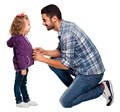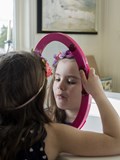 Learning to dress independently is an important life skill. It gives your child a sense of achievement to master a new skill.
Learning to dress independently is an important life skill. It gives your child a sense of achievement to master a new skill.
First your child will be able to help you as you dress them. They will hold out a foot for you to put a sock on and push their arms through their sleeves. Next they will learn to undress. They will be able to take off socks, pyjamas and anything without fastenings.
Then they will learn to put on clothing without fastenings. Then they will be able to take off and put on their clothes with some help with fastenings. Finally they will manage fastenings by themselves.
 Involve your child in undressing and dressing. You can do this when they are babies. Talk about what you are doing. Name body parts. Sing songs about dressing. Follow the same routine. Your baby will get to know what is coming next. Be playful. Put their socks on your ears or on their hands. Let them make a choice about what to wear. "Do you want the blue t-shirt or do you want the red t-shirt?".
Involve your child in undressing and dressing. You can do this when they are babies. Talk about what you are doing. Name body parts. Sing songs about dressing. Follow the same routine. Your baby will get to know what is coming next. Be playful. Put their socks on your ears or on their hands. Let them make a choice about what to wear. "Do you want the blue t-shirt or do you want the red t-shirt?". Physically assist your child. Put your hands over your child's and help them to get dressed.
Physically assist your child. Put your hands over your child's and help them to get dressed.
Show your child. Put your clothes on at the same time as your child and show them what to do.
Tell your child. Talk your child through the steps.
Try each of these ways to find what works for your child. Sometimes you might need to use more than one of these methods. Please remember that some children cannot look and listen at the same time. You are aiming to give the least amount of support needed. If you start by physically helping your child, work towards showing them what to do. Then work towards telling them what to do.
 Instead of automatically correcting a mistake (e.g. twisted collar or button incorrectly matched) why not encourage your child to look in the mirror and get them to find out what's wrong. You may need to ask them some questions to help them work it out.
Instead of automatically correcting a mistake (e.g. twisted collar or button incorrectly matched) why not encourage your child to look in the mirror and get them to find out what's wrong. You may need to ask them some questions to help them work it out.
Last reviewed July 2021.